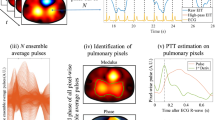Abstract
There is a strong clinical demand for devices allowing continuous non-invasive monitoring of central blood pressure (BP). In the state of the art a new family of techniques providing BP surrogates based on the measurement of the so-called pulse wave velocity (PWV) has been proposed, eliminating the need for inflation cuffs. PWV is defined as the velocity at which pressure pulses propagate along the arterial wall. However, no technique to assess PWV within central arteries in a fully unsupervised manner has been proposed so far. In this pilot study, we provide first experimental evidence that electrical impedance tomography (EIT) is capable of measuring pressure pulses directly within the descending aorta. To obtain a wide range of BP values, we administrated noradrenalin and nitroglycerine to an anesthetized pig under mechanical ventilation. An arterial line was inserted into the ascending aorta for measuring reference BP. EIT images were generated from 32 impedance electrodes placed around the chest at the level of the axilla. Regions of Interest (ROI) such as the descending aorta and the lungs were automatically identified by a novel time-based processing algorithm as the respective EIT pixels representing these structures. The correct positions of these ROIs were confirmed by bolus injections of highly conductive concentrated saline into the right heart and into the ascending aorta. Aortic pulse transit time (PTT) values were determined as the delay between the opening of the aortic valve (obtained from arterial line) and the arrival of pressure pulses at the aortic ROI within the EIT plane. For 11 experimental conditions, with mean BP ranging from 73 to 141 mmHg, strongly significant correlation (r = −0.97, P < 0.00001) between central BP and aortic PTT was observed, suggesting that EIT-derived aortic PTT is a potential non-invasive surrogate of central BP.





Similar content being viewed by others
References
Davies RJ, Jenkins NE, Stradling JR (1994) Effect of measuring ambulatory blood pressure on sleep and on blood pressure during sleep. BMJ 308:820–823
Frerichs I, Hinz J, Hermann P, Weisser G, Hahn G, Quintel M, Hellige G (2002) Regional lung perfusion as determined by electrical impedance tomography in comparison with electron beam CT imaging. IEEE Trans Med Imaging 21:646–652
Holder DS (2005) Electrical impedance tomography: methods, history and applications. In: Holder D (ed) Medical physics and biomedical engineering. Institute of Physics Publishing, Bristol
Hurwitz BE, Shyu LY, Reddy SP, Schneiderman N, Nagel JH (1990) Coherent ensemble averaging techniques for impedance cardiography. In: Proceedings of the third annual IEEE symposium on computer-based medical systems, Chapel Hill
Laurent S, Cockcroft J, Bortel LV, Boutouyrie P, Giannattasio C, Hayoz D, Pannier B, Vlackoppoulos C, Wilkinson I, Struijker-Boudier H (2006) Expert consensus document on arterial stiffness: methodological issues and clinical applications. Eur Heart J 27:2588–2605
Nichols WW, O’Rourke MF (2005) McDonald’s blood flow in arteries. Hodder Arnold, London
O’Rourke M (2009) Time domain analysis of the arterial pulse in clinical medicine. Med Biol Eng Comput 47:119–129
Parati G, Stergiou GS et al (2008) European Society of Hypertension guidelines for blood pressure monitoring at home: a summary report of the Second International Consensus Conference on Home Blood Pressure Monitoring. J Hypertens 26:1505–1530
Solà J, Vetter R, Renevey Ph, Chételat O, Sartori C, Rimoldi SF (2009) Parametric estimation of pulse arrival time: a robust approach to pulse wave velocity. Physiol Meas 30:603–615
Solà J, Rimoldi SF, Allemann Y (2010) Ambulatory monitoring of the cardiovascular system: the role of pulse wave velocity. In: Campolo D (ed) New developments in biomedical engineering. I-Tech Education and Publishing, Vienna
Author information
Authors and Affiliations
Corresponding author
Rights and permissions
About this article
Cite this article
Solà, J., Adler, A., Santos, A. et al. Non-invasive monitoring of central blood pressure by electrical impedance tomography: first experimental evidence. Med Biol Eng Comput 49, 409–415 (2011). https://doi.org/10.1007/s11517-011-0753-z
Received:
Accepted:
Published:
Issue Date:
DOI: https://doi.org/10.1007/s11517-011-0753-z




